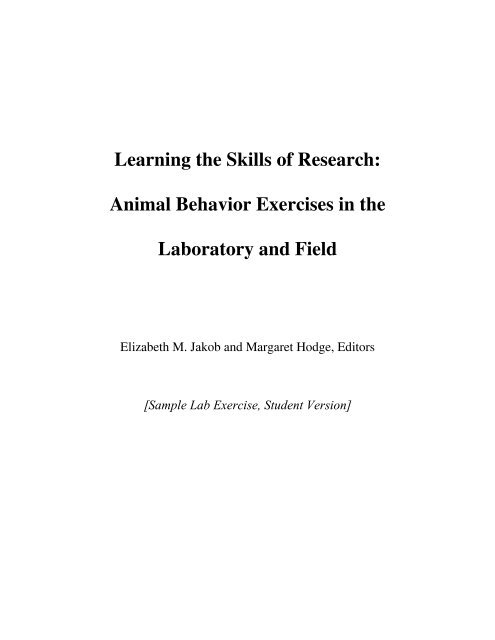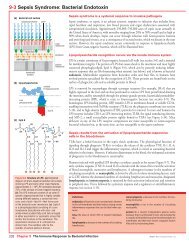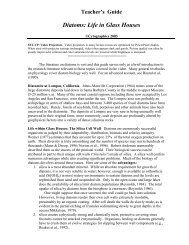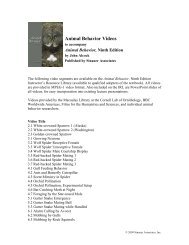Learning the Skills of Research:
Learning the Skills of Research:
Learning the Skills of Research:
You also want an ePaper? Increase the reach of your titles
YUMPU automatically turns print PDFs into web optimized ePapers that Google loves.
<strong>Learning</strong> <strong>the</strong> <strong>Skills</strong> <strong>of</strong> <strong>Research</strong>:<br />
Animal Behavior Exercises in <strong>the</strong><br />
Laboratory and Field<br />
Elizabeth M. Jakob and Margaret Hodge, Editors<br />
[Sample Lab Exercise, Student Version]
Goals<br />
Exercise 6 (Student): The Collection <strong>of</strong> Behavioral Data<br />
1. To practice <strong>the</strong> two most common methods <strong>of</strong> behavioral data collection.<br />
2. To understand <strong>the</strong> situations for which each method is most appropriate.<br />
Susan W. Margulis<br />
Additional files on CD: Video clips <strong>of</strong> meerkats and gibbons, example data sheet.<br />
Background<br />
Now that you’ve learned <strong>the</strong> basic differences between continuous, focal sampling<br />
and instantaneous sampling, you will next have <strong>the</strong> opportunity to practice <strong>the</strong>se methods.<br />
In this lab, we will provide you with two ethograms (see Exercise 3 for more detail about<br />
ethograms and how <strong>the</strong>y are constructed). One is for meerkats (Suricata suricata) and <strong>the</strong><br />
o<strong>the</strong>r is for white-cheeked gibbons (Hylobates concolor). Familiarize yourself with <strong>the</strong>se<br />
ethograms.<br />
Methods<br />
Choose a partner to work with. Begin with <strong>the</strong> video clip <strong>of</strong> meerkats. Meerkats are<br />
a type <strong>of</strong> mongoose. They inhabit arid areas <strong>of</strong> sou<strong>the</strong>rn Africa, and live in groups that<br />
usually consist <strong>of</strong> several families. When foraging, one member <strong>of</strong> <strong>the</strong> group can usually
e found standing upright scanning <strong>the</strong> surroundings for danger. This individual is <strong>of</strong>ten<br />
referred to as a “sentry.”<br />
You will be doing an instantaneous, scan sample <strong>of</strong> <strong>the</strong> animals in this group.<br />
Carefully review <strong>the</strong> ethogram and data sheet.<br />
The camera will pan (or “scan”) across <strong>the</strong> group. Watch <strong>the</strong> tape at least once<br />
before you begin your observation.<br />
On your data sheet, tally up how many animals you see engaged in each behavior.<br />
Note that you may not always see <strong>the</strong> same number <strong>of</strong> animals, as <strong>the</strong>y may run in or out<br />
<strong>of</strong> <strong>the</strong> range <strong>of</strong> <strong>the</strong> camera. You and your partner may alternate roles <strong>of</strong> observer<br />
(watching <strong>the</strong> tape and calling out what each animal is doing) and recorder (writing <strong>the</strong><br />
tally marks on <strong>the</strong> sheet).<br />
Next, move on to <strong>the</strong> video clip <strong>of</strong> gibbons. White-cheeked gibbons are lesser apes<br />
from sou<strong>the</strong>ast Asia. They live in small family groups. Both mo<strong>the</strong>r and fa<strong>the</strong>r care for<br />
<strong>the</strong> <strong>of</strong>fspring. Females are blonde, and males are black. All infants are born with blonde<br />
hair, which turns black at about a year <strong>of</strong> age. Males retain <strong>the</strong>ir black hair, while<br />
females’ hair becomes blonde again as <strong>the</strong>y approach maturity. The group you will<br />
observe consists <strong>of</strong> a mo<strong>the</strong>r and fa<strong>the</strong>r, and <strong>the</strong>ir year-old son.<br />
You will be doing a continuous, focal observation <strong>of</strong> <strong>the</strong> infant gibbon. Carefully<br />
review <strong>the</strong> ethogram and data sheet. Watch <strong>the</strong> tape at least once before you begin your<br />
observation.<br />
Use <strong>the</strong> timer in <strong>the</strong> upper left corner <strong>of</strong> <strong>the</strong> screen to note on your data sheet <strong>the</strong><br />
time at which a behavior state changes, or an event occurs. Check <strong>the</strong> appropriate<br />
behavior column. Your first entry should always be at time 0:00 (0 minutes and 0
seconds). For those behaviors that involve more than one animal (<strong>the</strong> focal subject plus<br />
ano<strong>the</strong>r animal) be sure to indicate on your data sheet which animals are involved and<br />
who initiates a behavior. For example, “mom touches baby” is not <strong>the</strong> same as “baby<br />
touches mom.” Be consistent in your use <strong>of</strong> abbreviations. You may use “m” for mo<strong>the</strong>r,<br />
“f” for fa<strong>the</strong>r, and “b” for baby. You may work with your partner or each do an<br />
independent observation, and compare your results.<br />
Now look at <strong>the</strong> sample data on your CD. Compare your observations to <strong>the</strong><br />
researcher sample. Open <strong>the</strong> “mock data” table, and use <strong>the</strong>se data to calculate <strong>the</strong><br />
percent agreement between two observers, following <strong>the</strong> instructions in <strong>the</strong> table legend.<br />
Questions<br />
In your write-up, include copies <strong>of</strong> your data sheets, and those <strong>of</strong> your partner or a<br />
member <strong>of</strong> ano<strong>the</strong>r group. Please address <strong>the</strong> following points:<br />
1. The similarity between observers is called interobserver reliability. How similar were<br />
your observations to ano<strong>the</strong>r student’s observations? How similar were <strong>the</strong>y to <strong>the</strong><br />
“researcher sample” observations?<br />
2. How do you explain any observed differences? Why is it important to minimize<br />
<strong>the</strong>se? What could you do to maximize interobserver reliability?<br />
3. Do you think it is possible to eliminate all interobserver variation? Elaborate.<br />
4. What was <strong>the</strong> percent agreement calculated from <strong>the</strong> mock data?<br />
5. What sort <strong>of</strong> questions about meerkat behavior could be addressed with <strong>the</strong> type <strong>of</strong><br />
data that you collected? What about <strong>the</strong> gibbons?
Acknowledgments<br />
Video footage was provided by Brookfield Zoo (© 2000 Chicago Zoological<br />
Society), and was filmed by Howard Greenblatt. The data sheets were developed in<br />
collaboration with <strong>the</strong> Center for <strong>Learning</strong> Technologies in Urban Schools, with partial<br />
funding by NSF grant DGE-9809636.<br />
Fur<strong>the</strong>r Reading<br />
Altmann, J. 1974. Observational study <strong>of</strong> behavior: sampling methods. Behaviour 49:<br />
227–265.<br />
Lehner, P. N. 1996. Handbook <strong>of</strong> Ethological Methods. 2 nd edition. Cambridge<br />
University Press, NY.<br />
Martin, P. and Basteson, P. 1993. Measuring Behavior: An Introductory Guide. 2 nd<br />
edition. Cambridge University Press, New York.
Methods<br />
SCAN SAMPLING—Meerkats<br />
Use scan (instantaneous) sampling to record <strong>the</strong> behavior <strong>of</strong> all meerkats that you<br />
see at 30-second intervals for 3 minutes. Using <strong>the</strong> ethogram provided below, enter on<br />
your data sheet <strong>the</strong> number <strong>of</strong> individuals in each behavior category on each scan.<br />
Always begin your scan when <strong>the</strong> stopwatch beeps. Always start your scan at <strong>the</strong> same<br />
location. You may work in pairs, with one member serving as <strong>the</strong> “recorder” and one <strong>the</strong><br />
“observer.” Switch roles mid-way through.<br />
States (for definition, see Exercise 4)<br />
Ethogram<br />
• Forage: Animal consumes or manipulates food or digs in <strong>the</strong> dirt in search <strong>of</strong><br />
food.<br />
• Rest: Animal sits or lies immobile, eyes open or closed, not doing anything<br />
else.<br />
• Play: Animals engage in rough and tumble social interaction or chasing.<br />
• Sentry: Animal stands upright on hind legs, alert, looking at surroundings.<br />
• Locomote (LOC): Animal runs, walks, or climbs around exhibit.<br />
• Social Groom (SOC.GM): Animal uses its teeth or front paws to comb<br />
through ano<strong>the</strong>r animal’s fur.<br />
• O<strong>the</strong>r: Any o<strong>the</strong>r behavior not listed above.
Methods<br />
FOCAL SAMPLING—White-Cheeked Gibbon<br />
Use continuous focal animal sampling to record <strong>the</strong> behavior <strong>of</strong> <strong>the</strong> baby white-<br />
cheeked gibbon. Using <strong>the</strong> ethogram provided below, observe <strong>the</strong> youngster for 3<br />
minutes. Whenever he changes his behavioral state, write down <strong>the</strong> time (minutes and<br />
seconds) and check <strong>the</strong> appropriate behavior column. Whenever he performs an event,<br />
write <strong>the</strong> time and mark in <strong>the</strong> column who is involved in <strong>the</strong> behavior: (M)o<strong>the</strong>r,<br />
(F)a<strong>the</strong>r, (B)aby. For example, if <strong>the</strong> Fa<strong>the</strong>r bites <strong>the</strong> Baby, write “FB” in <strong>the</strong> BITE/HIT<br />
column.<br />
States (for definition, see Exercise 4)<br />
Ethogram<br />
• Rest: Animal sits, stands, or lies; immobile; no o<strong>the</strong>r activity. Eyes open.<br />
• Locomotion/ Explore (LOC): Any movement by <strong>the</strong> animal, on <strong>the</strong> ground,<br />
rocks, or in trees.<br />
• Forage: Animals searches for, manipulates, or consumes food or water.<br />
• Groom: One animal runs its fingers or teeth through <strong>the</strong> fur <strong>of</strong> ano<strong>the</strong>r.<br />
• Play: Manipulation <strong>of</strong> objects or apparently purposeless movement. May<br />
involve ano<strong>the</strong>r animal. Note who is involved and describe <strong>the</strong> play.<br />
• On Mom: Infant clings to fur <strong>of</strong> mo<strong>the</strong>r.<br />
• O<strong>the</strong>r: Any behavior not listed above.<br />
• Out <strong>of</strong> View (OOV): Animal is not visible.
Events (For definition, see Exercise 4)<br />
• Touch: One animal puts hand on <strong>the</strong> arm, head, or o<strong>the</strong>r body part <strong>of</strong> ano<strong>the</strong>r<br />
animal. Gesture is gentle and friendly, not aggressive.<br />
• Bite/Hit: Aggressive, hard, rapid touch or push, or placing mouth on ano<strong>the</strong>r<br />
animal and closing with apparent force.
Scan<br />
1<br />
2<br />
3<br />
4<br />
5<br />
6<br />
7<br />
Sentry<br />
Meerkat Scan Data Sheet (see Excel file)<br />
Forage<br />
Locomote<br />
Date _______________ Time _______________ Observer _______________<br />
Rest<br />
Play<br />
Soc.Groom<br />
O<strong>the</strong>r<br />
Comments
Time<br />
0:00<br />
Rest<br />
Gibbon Focal Data Sheet (see Excel file)<br />
Locomotion<br />
Forage<br />
STATES EVENTS<br />
Groom<br />
Date _______________ Time _______________ Observer _______________<br />
Play<br />
On Mom<br />
O<strong>the</strong>r<br />
OOV<br />
Touch<br />
Bite/Hit<br />
Comments












